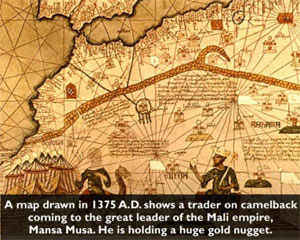 |
|
Lesson Title: Mali
Name: Mary Ellen Sturm
Discipline: Social Studies/World History and Culture
School: Rosa Parks Middle School
Grade: 7, Middle School
I. Conceptual Framework
Big idea: Continuity and Change
Rationale: Students will be studying Africa during the middle ages in an attempt to view the medieval world from a perspective other than the European.
Essential Question: How did the culture of ancient Mali show both continuity and change?
Key Concepts:
State and Local Standards:
Essential Learner Outcomes:
Students will summarize the importance of the political, economic, and social life of Mali and other African empires and analyze the role of Islam in Africa. Students will describe the major traditions, customs, and beliefs of Islam and its expansion into North Africa. Students will analyze characteristics that are used to organize people into cultures. Students will analyze how the environment and cultural diffusion influence the development of the United States and other cultures.Maryland VSC Alignment:
Analyze how diverse cultures shape a pluralistic society. Use strategies to prepare for reading. Use strategies to monitor understanding and make meaning from text. Draw conclusions and make generalizations based on multiple texts. Use formal writing to inform.
II. Topics
Short Abtract of the Lesson:
Prior to this lesson, students will have read in their textbook and taken notes about culture in traditional Mali and culture in Mali at the time of Mansa Musa. Then, students will be examining primary and secondary sources, including pictures, to describe the culture of the kingdom of Mali. Finally, students will write a letter from the viewpoint of an Arab trader describing aspects of culture in the kingdom of Mali.
III. Artworks
IV. Lesson
Lesson Objectives: Students will analyze documents to describe the culture of kingdom of Mali. Students will describe the kingdom of Mali as a source of both continuity and change.
Lesson Components:
Before Reading: Students will view a picture of the first map drawn by an Italian mapmaker showing West Africa. (This picture is found on page 120 of Across the Centuries and is also available in the National Geographic Society Picture Pack, Ancient Africa, transparency # 26, and at several sites online).
- What does this picture tell you about life in the kingdom of Mali?
- Class will discuss their responses.
During Reading: Students will read examine primary and secondary source documents. Students will take notes on a graphic organizer.
After Reading: Class will discuss their findings after reading and examining documents.
Closure/Assessment to check for understanding: Students will use their graphic organizer to compose a letter that accurately describes the culture in the kingdom of Mali. The letter should include details of how life in ancient Mali reflected both continuity of traditional practices and change due to Islam. The letter will be written from the viewpoint of an Arab trader visiting the kingdom of Mali for the first time with Ibn Battuta.
Materials/Resources:
Textbook: Armento, Beverly J.; Cordova, Jacqueline M.; Klor de Alva, J. Jorge; Nash, Gary B.; Ng, Franklin; Salter, Christopher L.; Wilson, Louis E.; and Karen Wixson. Across the Centuries. Boston: Houghton Mifflin, 2003.. 118-127.
Primary Source documents written by Ibn Battuta from:
- http://www.nipissingu.ca/department/history/MUHLBERGER/2805/battuta.htm
- http://www.sfusd.k12.ca.us/schwww/sch618/Ibn_Battuta/Ibn_Battuta_Rihla.html
- Ibn Battuta, Travels in Asia and Africa 1325-1354, tr. and ed. H. A. R. Gibb (London: Broadway House, 1929)
Oral documents told by Griot Mamadou Kouyate from:
- Niane, D.T. Sundiata, An Epic of Old Mali. Longman Group Limited, Essex, England, 1965, p. 2.
Niane, D.T. Sundiata, An Epic of Old Mali. Longman Group Limited, Essex, England, 1965, p. 41.
Niane, D.T. Sundiata, An Epic of Old Mali. Longman Group Limited, Essex, England, 1965, p. 52.Photographs:
- http://africa.si.edu/collections/
- http://www.andygilham.com/mali.htm
- http://www.burkinabymatt.com/index.php?subject=culture&photo=tabaski_prayer
- http://www.ruf.rice.edu/~anth/arch/mali-interactive/pictures/empires.jpg
- http://www.homestead.com/wysinger/i8_000dd.jpg
- http://www.nationalgeographic.com/tattoos/gallery/images/photos/west_africa_scarification.jpg
- www.loc.gov/exhibits/mali
- www.mandinkapeople.com
Assessment: Students will use their graphic organizer to write a letter that describes the culture in the kingdom of Mali. They will be asked to take the viewpoint of an Arab trader who is visiting Mali for the first time with Ibn Battuta and is writing home to his family in Arabia. The letter will need to include details about the culture including ways of making a living, customs, housing and religion. The letter will be graded for proper letter format and content. The letter should include details of how life in the kingdom of Mali reflected both continuity of traditional practices and change due to Islam.
Keywords: ancient Mali, kingdom of Mali, Islamic, Sundiata, Ibn Battuta, Mansa Musa, hajj, pluralistic society, cultural diffusion, continuity, change